
by Molly Jameson | Oct 30, 2025

A simple wooden bin provides airflow and space for layering “browns” and “greens” to create balanced compost at home. Photo by Molly Jameson.
The Dirt on Compost: Hot and Worm Composting at Home
Every week, many of us dump spoiled food or leftovers into the trash and haul yard waste to the curb, not realizing that all of that organic material could be turned into something incredibly useful. Composting is the answer. It’s a simple, natural process that transforms food scraps and yard debris into a rich soil amendment that feeds your plants and improves soil health.
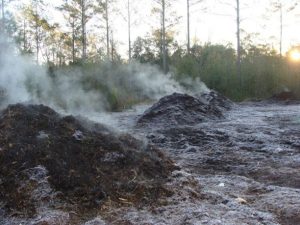
Microbial activity generates heat as organic matter breaks down, causing visible steam to rise from active thermophilic compost piles on cool mornings. Photo by Turkey Hill Farm.
There are two main ways to compost at home: thermophilic (hot) composting and vermicomposting (composting with worms).
Thermophilic composting is the classic backyard method that relies on heat-loving microbes to break down organic material. With the right mix of “browns” (carbon-rich materials like dried leaves, cardboard, and straw) and “greens” (nitrogen-rich materials like vegetable scraps, coffee grounds, and grass clippings), the pile heats up to between 130–160°F. This high heat speeds up decomposition and kills weed seeds and harmful pathogens. Turn the pile occasionally and keep it moist, and in a few months, you’ll have dark, earthy compost ready to mix into your garden beds.
Hot Composting Fun Facts
- Food scraps and yard waste make up nearly 30% of what we throw away, most of which could be composted instead.
- Microbes in a hot compost pile can double their population every 20–30 minutes under the right conditions.
- A compost pile needs at least one cubic yard (3x3x3 feet) of material to build enough mass to heat up properly.
- Steam rising from a compost pile on a chilly morning isn’t smoke – it’s water vapor from microbial activity.
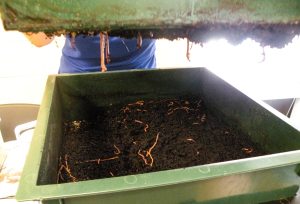
Red wiggler earthworms transform food scraps into nutrient-rich worm castings. Photo by Leon County.
Vermicomposting is a little different – and a bit squirmier. This method uses red wiggler earthworms (Eisenia fetida) to process kitchen scraps into a fine, nutrient-rich material called worm castings. Earthworm bins can be kept indoors or outside in a shaded area, making them a great option for those with limited space. It’s clean, odor-free when managed properly, and a surprisingly fun way to recycle your food waste.
Worm Composting Fun Facts
- Red wigglers can eat up to half their body weight in food scraps each day.
- Worms breathe through their skin and need moist bedding to survive and stay active.
- Worm castings contain five times more nitrogen and seven times more phosphorus than average topsoil.
- Worm castings contain beneficial microbes that help suppress certain plant diseases in soil.
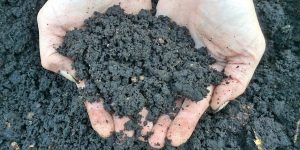
Finished vermicompost is dark, crumbly, and nutrient-rich – the result of red wigglers breaking down organic waste. Photo by John Edwards.
Both methods keep organic material out of the landfill, reduce methane emissions, and build healthier soil – something every gardener can appreciate.
If you’d like to learn even more about composting and hear additional fun facts about how nature recycles, join UF/IFAS Extension Agents Mark Tancig and Molly Jameson for The Dirt on Compost: Hot & Worm Composting at Home on Wednesday, November 12, from 6:00 to 8:00 p.m. at the Leon County Extension Office (615 East Paul Russell Road).
Register on Eventbrite: https://UFIFASLeonCompostingFall2025.eventbrite.com
This free workshop will explore the science behind composting and provide practical tips for both hot composting and worm composting systems.

by Larry Williams | Dec 4, 2019
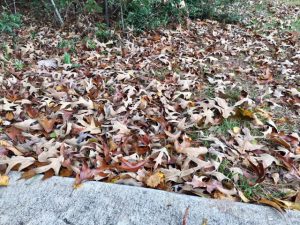
Fall oak tree leaves abound and can be recycled as landscape mulch. Photo credit: Larry Williams
Weed control is not top on my list as a reason to use mulch. There are weeds that can push through mulch such as nutsedge (nutgrass) or that can germinate and grow in the mulch. But done correctly, mulching plant beds and gardens can help inhibit some weeds. Tree leaves can be used as a mulch.
In addition to weed control, mulch provides other benefits. It can make landscapes look more attractive. It keeps roots evenly moist, acts to insulate roots from extreme heat and cold and can help decrease loss of soil from wind and water erosion. Mulch serves as a barrier to some soil-borne diseases, especially in the vegetable garden. And, as organic mulch breaks down, it improves the soil’s fertility, aeration, structure and drainage.
Tree leaves make good mulch. They can be placed on the soil surface beneath and around shrubs, trees, perennials, annuals and vegetables.
Fall leaves are abundant. Some people feel overwhelmed by the volume. One resident reported raking more than 100 large bags of leaves from his half-acre property. One large oak tree can contain over 250,000 leaves!
Tree leaves can be placed in landscape beds or around vegetables “as is” or chopped up with a shredder or mower into smaller pieces and then spread around vegetables, shrubs and trees. Mixing leaves from several different species of trees can make better leaf mulch. Leaves of the same size tend to mat together and produce a shingling effect that can shed water and reduce gas exchange in the soil. Shredded leaves stay seated better on the landscape than whole leaves.
A mulch layer three inches deep after settling is enough for most plants. If possible, extend the mulched areas out to the outermost leaves (called the drip line) and beyond. And be sure to pull the mulch back a few inches from the main trunk. Never pile mulch around the trunk.
Using those fallen tree leaves as mulch recycles a natural resource and saves you money, enriches your soil, fertilizes your plants and keeps them out of the local landfill.
So, instead of putting all those leaves curbside in plastic bags to be hauled off, use them to benefit your landscape, which may include less weeds.
For additional information on landscape/garden mulch, contact the UF/IFAS Extension Office in your County or access the following sites.
http://gardeningsolutions.ifas.ufl.edu/care/planting/mulch.html
http://edis.ifas.ufl.edu/topic_mulch
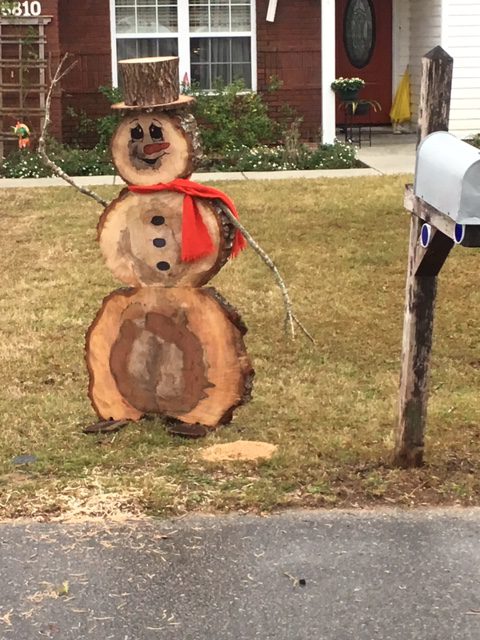
by Julie McConnell | Jan 3, 2019

Storm debris turned into holiday cheer in Bayou George. Photo: J_McConnell, UF/IFAS
By the time this article publishes, we will be more than 70 days since Hurricane Michael toppled or damaged an incredible number of trees in the Panhandle. Enormous piles of once stately shade trees line the streets in neighborhoods and business districts in. The cleanup efforts have been phenomenal, over 4 million cubic yards of storm debris picked up in Bay County to date, but there is still a long way to go in the recovery process.
So, as gardeners, how can you help our community get back on track amidst your own struggles to recover? A few Florida Friendly Landscaping™ Principles come to mind.
- #1 Right Plant, Right Place – as you rebuild your landscapes, make sure to choose the appropriate plant for the location. Consider mature size and give those plants space to thrive!
- #4 Mulch – do you have bare ground that will eventually become landscape beds or turf but no resources or time to replant yet? Consider mulching the area to keep soil from eroding and to help improve soil though decomposition of natural products. Hint – see Recycling for free sources!
- Mulch tips https://sfyl.ifas.ufl.edu/media/MulchBrochure.pdf
- keep mulch 12 inches from tree trunks
- recommended depth in beds or under dripline of tree canopy (excluding within 12” of trunk) is 2-3 inches
- leave an 18-24 inch buffer around building foundations mulch free to reduce conducive termite conditions
-

Dress up stumps with plants and whimsical designs. Photo: D_VanderMeer, UF/IFAS Master Gardener
#7 Recycle – driving around town I have seen some really creative uses for stumps, trunks, and branches that homeowners have constructed and messages of hope that bring a smile to my face. Another method of recycling is to use the chipped vegetative debris as mulch, either available as “utility mulch” by cities and counties or you may have some in your own yard right now.
- Utility mulch does come with some words of caution because there is an increased risk of introducing weeds to your landscape with untreated storm debris. However, if you need mulch for pathways or planting beds you will be helping your community’s cleanup effort by reducing waste accumulation. Just watch for “volunteer” plants and manage as needed.
In Bay County, there are 4 locations where you can load and haul off your own utility mulch from storm debris
- Under the Oaks Park – 5843 E. U.S. 98, Panama City, FL 32404
- G. Harder’s Park – 8110 John Pitts Rd., Panama City, FL 32401
- Chapman Park – 2526 Rollins Ave., Bayou George, FL 32404
- Laird Park – 6310 Laird Park Rd., Panama City, FL 3240
For sources in your county, check with your Solid Waste Department for utility mulch availability.
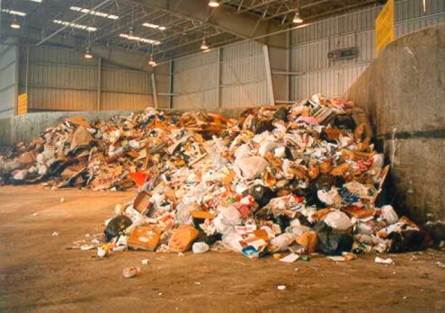
by Molly Jameson | Mar 13, 2018
Food is wasted along the many routes in our food system as it is grown, processed, transported, sold, stored, and prepared. According to the Environmental Protection Agency, the U.S. generates more than 37 million tons of food waste annually, 95 percent of which ends up in landfills or incinerators. That amounts to over 200 pounds of wasted food per every American every year!
Food waste in landfills combines with anaerobic conditions (lack of air) to create methane, a powerful greenhouse gas 25 times more harmful than carbon dioxide. Landfills are responsible for 18 percent of total methane emissions in the U.S., which contributes significantly to climate change.
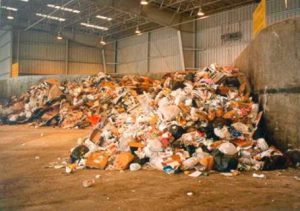
Waste waiting for the landfill. Ninety-five percent of the 37 million tons of food waste we produce annually ends up in landfills, when combined with anaerobic conditions, generates methane. Photo by Heidi Copeland.
Nationally, we can prevent and recover food waste by implementing techniques such as standardized food labeling, streamlined donations to foodbanks, the creation of secondary grocers, industrial composting, clean energy creation through treatment plant digestion, business and consumer education, and changing overall food policy.
But as a gardener, what can you do to help? If you grow fruits and vegetables, you are already helping, as this means the food from your garden did not have to travel long distances to get on your dinner table. If you actively compost your kitchen scraps, you are also helping, as Americans throw out nearly 40 percent of food purchased. Here are a few other simple life-style changes you might want to try:
- Purchase more locally produced food. Buying local not only supports local farmers, but the food most likely used fewer resources than non-local food on its way to market.
- Learn canning and pickling techniques. Homegrown fruits and vegetables are as fresh as you can get, and canning can then preserve this food for months.
- Store food properly and keep perishables and leftovers in plain sight in the refrigerator so you see them every time you open the door. Investing in a good set of clear glass reusable containers can securely store leftovers, make them easier to identify, and can be safely heated for quick consumption.
- Don’t throw out something just because it is past the date on the label. Unless it is baby food or formula – which federal law mandates be dated to ensure consumption when most nutritious – these dates refer only to peak quality. If the items do not show signs of spoilage, such as an off odor, texture, flavor, they are safe to consume.
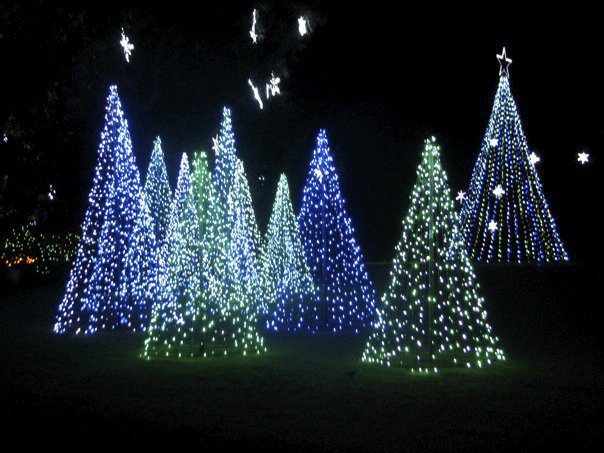
by Carrie Stevenson | Nov 25, 2014
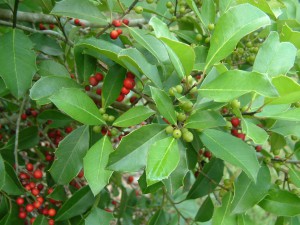
The Savannah holly has beautiful leaves and berries throughout the winter. Photo credit: Carrie Stevenson
As the holiday season comes upon us, many folks will be spending their weekends scouring tree farms and mall parking lots for the perfect Christmas tree. There are many very realistic-looking options for artificial trees these days, and they are a great way for families to reduce waste by reusing the same tree year after year. However, a live Christmas tree brings greenery inside, smells wonderful, and provides a central focus for many of our holiday traditions. Many cut trees will last over a month with good watering, but when the holidays are over, what do you do with your tree?
Many cities and counties offer a Christmas tree recycling program, in which trees can be left at drop-off sites or on the curb for pickup. Most municipalities turn the trees into mulch and use it at public facilities. Many individuals reuse trees by placing them in lakes or other water bodies as fish habitats, creating reefs for hiding and nesting. However, be sure and check with local environmental agencies before placing trees under water. If you own a good bit of land or a wooded area, you can lay your old tree out for small mammals and birds to use as shelter. It will eventually biodegrade and add nutrients to the soil. Be sure that if you take advantage of any of these recycling options that you remove all ornaments, tinsel, or other decorations which could be hazardous to animals and/or wood-chipping machines.
There is an option to truly keep your tree evergreen—a live Christmas tree! Many retailers sell potted trees that can be brought inside and decorated, then planted outside after the season is over. One of the plants often associated with this festive time of year is holly, which is an excellent choice for evergreen color throughout the year. There are many native varieties, such as yaupon holly for drier areas and myrtle-leaved holly for wetlands. Hollies are typically used as shrubs in the landscape, although many species can grow into small trees if allowed; the East Palatka holly can be as tall as 45 feet at maturity! Hollies are also an excellent food choice for attracting birds, and the shrubs work wonderfully as a natural screen. While their branches aren’t quite as sturdy as some of the northern varieties, native Atlantic white or Eastern red cedar–or even some local pines–are also excellent evergreen species that can be used.
A live tree or one planted and decorated outdoors is a wonderful way to commemorate a special Christmas and help provide wildlife habitat year-round.
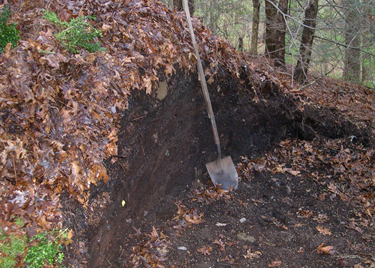
by | Aug 5, 2013
With all of the rainy weather Northwest Florida has been having this summer, plenty of excess yard debris is littering our yards. Don’t put it in the landfill, Compost It !
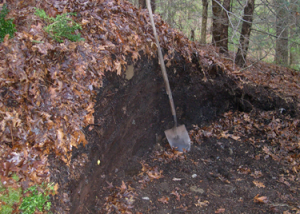
Compost Pile
Compost is used primarily in bed preparation to improve the soil and can even be used in preparing potting mixes. Partially composted material also can be used as mulch. And since homemade compost is free, it helps reduce the cost of gardening – which means more money left over to buy plants.
Returning these organic materials to the garden maintains natural biological cycles and is an ecologically sensible means of recycling organic waste. It is never very efficient nor environmentally friendly to pile up leaves and grass clippings in bags on the curb to be hauled away to rapidly filling landfills and then go out and buy peat moss that has been dug up and shipped in from Canada.
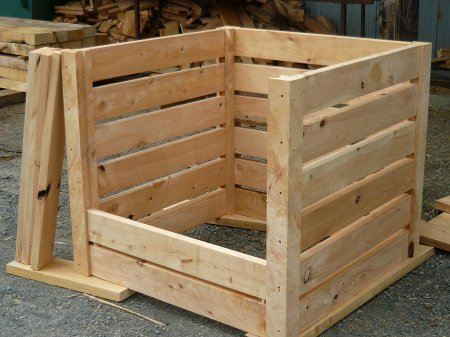
Build Your Own!
Compost piles should be located in a convenient, but out-of-the-way, location. A source of water nearby is helpful. Avoid locating the pile against fences or other structures made out of wood, because the constant moisture can cause decay. Make the pile about 3 feet wide by 3 feet deep by 3 feet wide to 5 by 5 by 5 in size. Anything smaller will not decompose as well, and larger piles are more difficult to work.
Although compost can be made just by stacking organic matter in a pile, most gardeners prefer to enclose the pile in a bin. There are a number of commercial bins on the market, or you can make your own very easily. A 15-foot-long piece of wire fencing material bent into a circle and fastened with a few pieces of wire is inexpensive, easy to build and works well. Avoid using untreated wood to build the bin, because that could lead to termite problems.
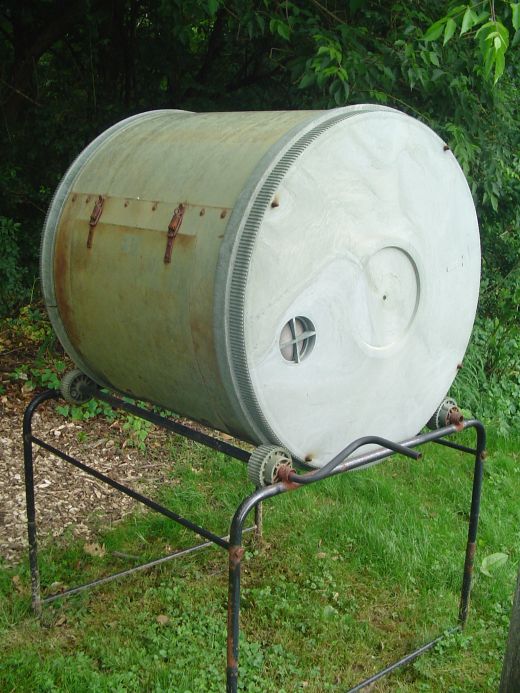
Commercial Bins Are Available
Compost can be created simply by piling up organic matter and allowing natural decomposition to take place (this is sometimes called passive composting). There is nothing really complicated about it, although using this method requires patience. Depending on circumstances, it may take six to 12 months for the organic matter to fully compost.
Typically, composting uses various techniques to speed up the natural breakdown of yard waste. It’s important to remember that raw organic material is converted into compost by the action of fungi and bacteria. In active composting, processes are set in place to make these organisms work faster and more efficiently.
These fungi and bacteria require adequate nitrogen, oxygen and moisture to decompose organic matter rapidly. The composting process attempts to provide these requirements, and the better those essentials are supplied, the faster the process will occur. Shredding or finely chopping materials also greatly speeds up the process.
As the microbes decompose the organic materials, temperatures within the pile may approach 160 degrees at the center. When properly done, this process produces a rich, earthy smell, not the bad odors many gardeners fear will occur. In addition, properly maintained compost piles will not attract and harbor vermin such as rats.
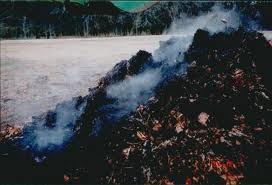
During Decomposition Compost Piles Get Very Warm
Try to include a variety of materials to encourage rapid decomposition. The more types of acceptable materials that are added the better the composting process.
Brown materials, such as brown leaves or chipped branches and stumps, are relatively low in nitrogen. Adding a commercial fertilizer or an organic fertilizer (such as blood meal) that contains nitrogen encourages rapid, thorough decomposition when these types of materials provide the bulk of what is being composted. A light sprinkling is applied over each 8- to 12-inch layer of organic matter as the pile is built.
If the pile is mostly green matter, turn it weekly to keep it loose and oxygenated.
Organic materials that can be used for composting include fallen leaves, grass clippings, shredded hedge clippings, raw vegetable and fruit trimmings, coffee grounds, dead houseplants and old flower arrangements. Manures, such as cow, horse, rabbit or poultry manures, make excellent additions to the compost and are relatively rich in nitrogen.
On the other hand, never put cooked foods, grease, meat, seafood scraps, fat or dog or cat droppings in the pile.
Oxygen is provided by enclosing the pile in a bin that has sides with a lot of ventilation openings, which allow air to move in and out. Turning the pile occasionally is labor intensive, but it ensures the pile is well aerated.
During dry weather it may be necessary to water the pile to maintain adequate moisture levels. Dry organic matter will not decompose. The pile should stay moist, but not constantly soggy. A pile that stays too wet does not contain enough oxygen and may produce sour odors. If this happens, turning the pile will correct the problem.
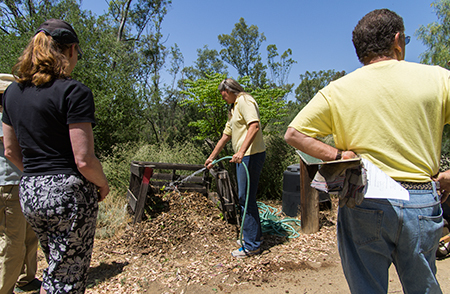
Water May Need to be Added During Dry Periods
As materials compost they lose more than half of their volume. When compost is ready for use, it should be dark brown and crumbly with much, or all, of the identity of the original material lost.
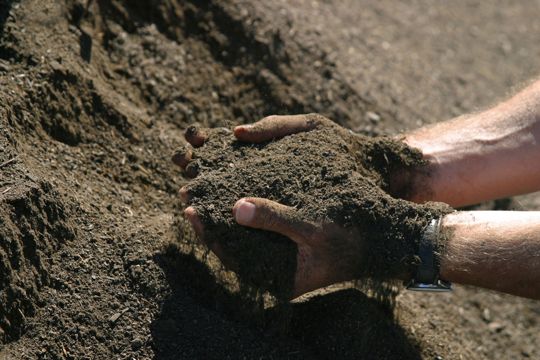
The Finished Product
The time it takes to finish varies depending on the materials used, how finely they were chopped and how well the appropriate moisture and oxygen levels were maintained. Two to six months is typical, but it can occur much faster. For more information, check out this great UF / IFAS publication on composting.





















